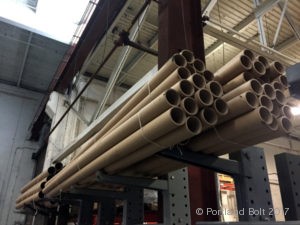All thread rods are produced two ways, depending on the availability of the diameter and grade. Common grades include ASTM A307 Grade A, A193 Grade B7, and several others through 2” in diameter. These common grades and sizes will typically be cut to size and finished from longer, mass-produced all thread rod. Odd grades and diameters will need to be manufactured from scratch. Both procedures are covered on this page and in our All Thread Rod Video.
Cut-to-Length All Thread Rod
Step 1: Cut All Thread Rod to Length
When specific lengths are required for a project, bolt suppliers will cut longer lengths of all thread rod into shorter pieces from all thread rod that has been mass-produced. Cutting is performed with a band saw.
Step 2: Chamfer Ends
Since all thread rod can easily get damaged during the manufacturing, handling, and shipping of an order, most manufacturers will chamfer the all thread rod ends to ensure that a nut will spin on without issue. Chamfering is a process where the rod is slightly beveled on the end by a machine that acts similar to a pencil sharpener. This beveled end allows for a nut to spin onto the all thread rod easily and prevents the potential issue of having a damaged first thread.
Step 3: Grade Identification
Most all thread rod requires a permanent grade symbol and manufacturer’s identifier on one end of each rod. One exception is ASTM F1554, which requires color coding unless a permanent grade identifier and/or manufacturer’s identifier is requested under the supplemental requirement. SAE J429 Grades 2, 5 and 8 all thread rod requires no grade marking. A hydraulic stampling machine applies these permanent identifiers after the rods have been cut and chamfered.
Nonstandard Grades
Some grade and diameter combinations of all thread rod are not mass-produced due to lack of usage. In these instances, all thread rod is “made from scratch”.
Step 1: Cut Round Bar to Length
Steel round bar measuring 20′, 24′, or 40′ in length is band saw cut or sheared to a length a few inches longer than the desired finished product.
Step 2: Cut Thread
Instead of rolling the thread as mass-producers do, most nonstandard all thread rod is threaded by cutting the threads into steel round bar. Instead of pitch diameter steel being extruded to form the threads as in roll threading, cut threading chasers remove steel from full-size round bar to form the threads. This method of threading is slower and more time consuming than roll threading, resulting in higher manufacturing costs. This form of threading is primarily used for specialized grades and large diameters of all thread rod which are not mass produced or available off the shelf.
Step 3: 2nd Cut
When pieces of round bar are fed into the cut threader, they must be held by a few inches on the end of the rod. Since there is no way to cut threads all the way to the end of the round bar, it must be cut off after threading is complete. Second cutting is performed with a band saw.
Step 4: Chamfer Ends
Ends are chamfered as described above.
Step 5: Grade Identification
Ends are marked as described above
Coatings
For more information about the different coatings available for all thread rod, click here.
Packaging and Shipping
 The final step in any manufacturing sequence is packaging the order and shipping it out to the customer. It is important to use high-quality packaging materials, especially with all thread rod, to ensure the product arrives to the job site intact and free of any damage. Because all thread rods can be easily damaged in transit, it is important to make sure the manufacturer uses the best packaging methods to take care of the all thread rod. Commonly, all thread rod in lengths longer than 6′ are shipped in thick, reinforced cardboard tubes.
The final step in any manufacturing sequence is packaging the order and shipping it out to the customer. It is important to use high-quality packaging materials, especially with all thread rod, to ensure the product arrives to the job site intact and free of any damage. Because all thread rods can be easily damaged in transit, it is important to make sure the manufacturer uses the best packaging methods to take care of the all thread rod. Commonly, all thread rod in lengths longer than 6′ are shipped in thick, reinforced cardboard tubes.
